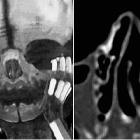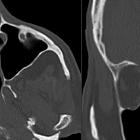Nasal septal deviation




Deviated nasal septums are a common, usually incidental, finding seen on brain and paranasal sinus CT studies. They are commonly seen with external nose deformities.
Clinical presentation
Symptomatic patients can present with unilateral nasal obstruction or less commonly epistaxis, obstructive sinusitis, and/or pain/pressure symptoms .
Pathology
Etiology
Nasal septum deviation can be congenital or acquired. The most common acquired cause is trauma from motor vehicle collisions, sports-related injuries, and altercations.
Associations
Deviated nasal septa are commonly associated with concha bullosa or turbinate hypertrophy with septal deviation being towards the contralateral side.
Complications
Unrecognised nasal septal deviations can contribute to failed rhinoplasty .
Radiographic features
Nasal septal deviation can be C-shaped, reverse C-shaped, S-shaped or reverse S-shaped .
Treatment and prognosis
If medical management fails, the most common surgical procedure performed is septoplasty .
Siehe auch:
und weiter:

 Assoziationen und Differentialdiagnosen zu Nasenseptumdeviation:
Assoziationen und Differentialdiagnosen zu Nasenseptumdeviation:



